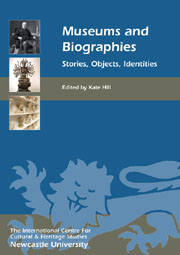Book contents
- Frontmatter
- Contents
- List of Illustrations
- Introduction: Museums and Biographies – Telling Stories about People, Things and Relationships
- INDIVIDUAL BIOGRAPHY AND MUSEUM HISTORY
- PROBLEMATISING INDIVIDUALS' BIOGRAPHIES
- INSTITUTIONAL BIOGRAPHIES
- 7 Significant Lives: Telling Stories of Museum Architecture
- 8 Schinkel's Museums: Collecting and Displaying Architecture in Berlin, 1844–1933
- 9 Personifying the Museum: Incorporation and Biography in American Museum History
- 10 Making an Exhibition of Ourselves
- 11 Institutional Autobiography and the Architecture of the Art Museum: Restoration and Remembering at the National Gallery in the 1980s
- OBJECT BIOGRAPHIES
- MUSEUMS AS BIOGRAPHY
- MUSEUMS AS AUTOBIOGRAPHY
- Endpiece: The Homunculus and the Pantograph, or Narcissus at the Met
- List of Contributors
- Index
7 - Significant Lives: Telling Stories of Museum Architecture
from INSTITUTIONAL BIOGRAPHIES
Published online by Cambridge University Press: 05 February 2013
- Frontmatter
- Contents
- List of Illustrations
- Introduction: Museums and Biographies – Telling Stories about People, Things and Relationships
- INDIVIDUAL BIOGRAPHY AND MUSEUM HISTORY
- PROBLEMATISING INDIVIDUALS' BIOGRAPHIES
- INSTITUTIONAL BIOGRAPHIES
- 7 Significant Lives: Telling Stories of Museum Architecture
- 8 Schinkel's Museums: Collecting and Displaying Architecture in Berlin, 1844–1933
- 9 Personifying the Museum: Incorporation and Biography in American Museum History
- 10 Making an Exhibition of Ourselves
- 11 Institutional Autobiography and the Architecture of the Art Museum: Restoration and Remembering at the National Gallery in the 1980s
- OBJECT BIOGRAPHIES
- MUSEUMS AS BIOGRAPHY
- MUSEUMS AS AUTOBIOGRAPHY
- Endpiece: The Homunculus and the Pantograph, or Narcissus at the Met
- List of Contributors
- Index
Summary
INTRODUCTION
This paper explores the potential of biography as a strategy for generating histories of museum buildings and provides a rationale for why this would be an important addition to the architectural history of museums and galleries and museum studies more broadly. Drawing on recent academic research in museum studies, architectural history and theory, as well as biography, autobiography and life writing, the chapter explores aspects of the subjects, methods and outcomes of architectural history. It asks questions about what such an approach might tell us about architecture and what histories it might reveal of museums, galleries and the people who have made them. The chapter argues that we need to develop subtle and nuanced approaches to the architectural history of museums and galleries, approaches which move beyond the lives of museum architects and linear histories of stylistic progress that continue to dominate the literature. Such histories produce a ‘smoothed out’ version of museum building of little use to the museums field and are complicit in the assertion that architecture is quite simply the activity and aesthetic outcome – the object – of the architect. When combined with recent critical thinking around the nature and production of architecture, a biographical approach can unearth detailed histories of architectural change and development (in relation to the physical structure) and provide glimpses of tangled stories of occupation and use, often revealing social and professional relationships and the politics and tensions behind architectural development.
- Type
- Chapter
- Information
- Museums and BiographiesStories, Objects, Identities, pp. 103 - 118Publisher: Boydell & BrewerPrint publication year: 2012



